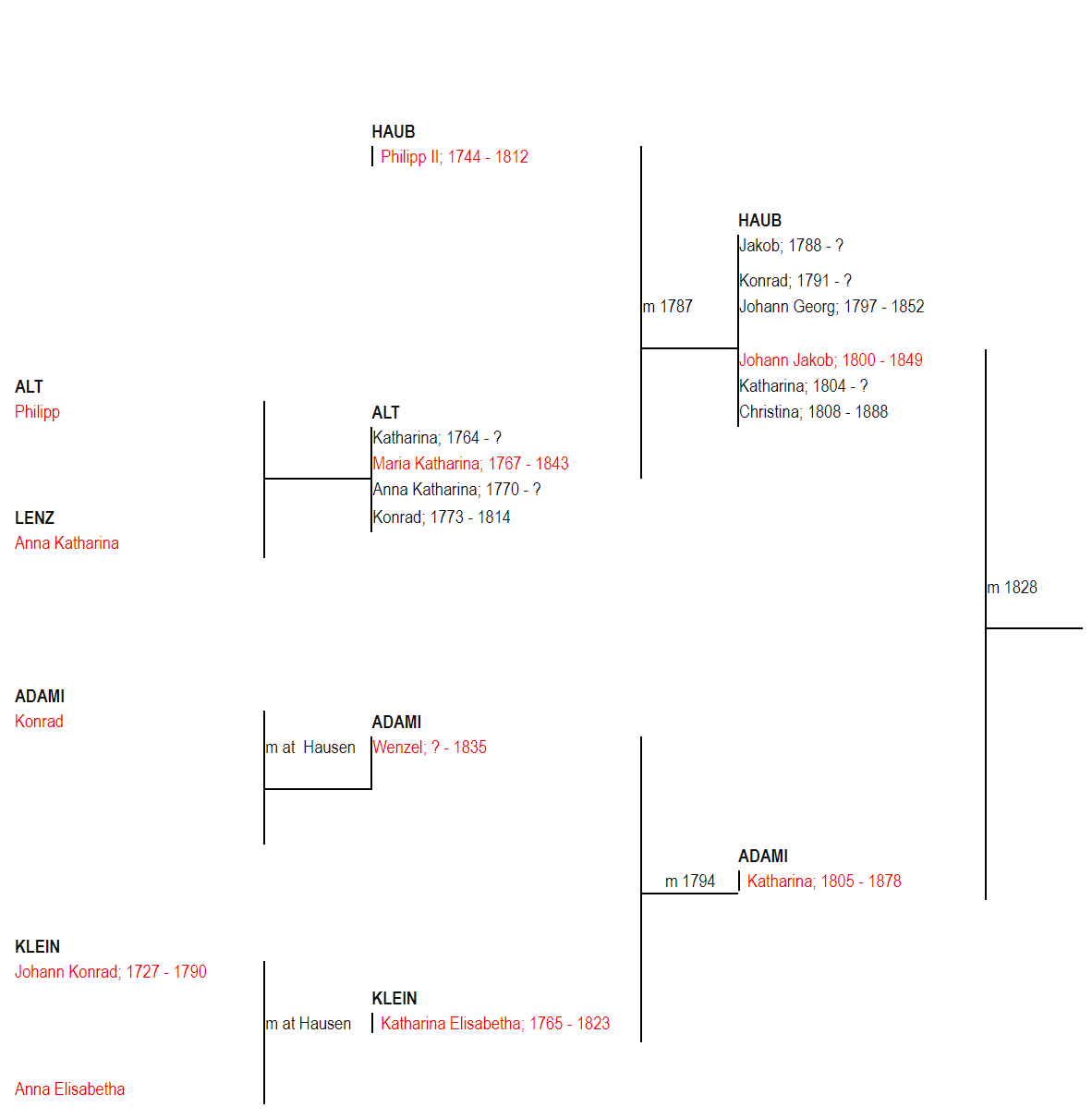Katharina ADAMI 1805-1878
A daughter of Wenzel Adami, Katharina was born in the village of Hausen, about 5 km west of Nieder-Weisel in the foothills of the Taunus Ranges. Her mother, Katharina Elisabetha Klein, was in her 41st year when Katharina was born on 24th June 1805. Though living in Hausen, Adami was from a Nieder-Weisel back-ground (Adami/Haub/Schnorr) and Katharina Elisabetha also had Nieder-Weisel ancestors (Rumpf, Maas, Marx & Krausgrill).
Katharina had moved to Nieder-Weisel after her mother died in 1823. She formed a liaison with the day-labourer Johann Jakob Haub, youngest of the five sons of Philipp Haub II; his family had farmed in the village for generations. The couple married in Nieder-Weisel on 9th November 1828, without prior proclamation as the bride was seven months pregnant. This baby was a girl but she did not survive the birth and therefore was not baptised. Konrad was born in 1830, Juliana in 1832, Katarina Elisabetha in 1834, Johann Georg 1836 and Jakob in 1845. Two other girls died soon after birth. Who would have predicted that four of the five children who survived, and their mother, were to die in Australia?
Katharina was widowed prematurely when Johann Jakob died in 1849 before turning 50. Law and order was still in short supply in the village and many parents sent their younger children away from the dangers facing them. Juliana went to England to live with other young emigrants in the industrial town of Hull; an enclave was formed there of members of the Haub, Heinz, Jung, Hildebrand and Maas families. Here, Katharina met and married Friedrich Geisler. With their year-old son, George, they left for Victoria in 1856.
When “Columbia” sailed from Liverpool on 1st December, the only foreigners on board were six people travelling under the name Keisler: Frederick 40, his wife Catherine 38, Jacob 9, George 1, Charles 20, and his wife Julia 18. Doubtless Catherine was Juliana’s mother with her son Jakob. He was nearly 12, but it was common practice to lower the age of a child to enable him/her to travel half fare and with the adults in the family.
The ages of the adults had been contrived to give credence to the deception that Julia was the wife of Charles, rather than of Frederick. He added ten years to his age and Catherine took thirteen from hers to bring them reasonably into line. Juliana had to lower her age by six years because she was now pretending to be the daughter of a woman aged 38.
The only logical reason for such a charade was to conceal the identity of “Charles” and to enable him to be with the family group rather than in the single men’s quarters. No record can be found in Victoria of such a person, lending support to the hypothesis that he was really Katharina’s son, Johann Georg, who was then 20 and liable to be conscripted into the army if he remained in Germany.
Arriving at Melbourne on 18th March 1857, Katharina went with the Geislers to Ballarat and then north to the goldfields around Maryborough. Juliana gave birth to a son, Jacob, at Avoca in 1859. When she was able to travel again, they moved back east again through Bendigo to Rushworth on the road to Shepparton. The Geislers settled here permanently, except for a couple of years in 1865-66 when they moved to Young in New South Wales. As Katharine’s records prove that she also spent two years in that State, it can be assumed that she went with them – so as to attend the marriage of her son Jacob in Young in 1866.
Eventually all of Katharina’s sons returned to Victoria. They lived in the Rushworth district, giving her the pleasure both of helping look after her unmarried sons, and of watching her grandchildren grow up. These called her Ella and they learned to understand her as she spoke to them in German. Sadly, this reuniting of her family ended in 1870 when Konrad was fatally injured in a mine collapse, in spite of the efforts of his 11 year old nephew to rescue him.
Katharina died on 11th June 1878, twenty-one years after getting to Australia. She is buried in the cemetery at Rushworth in a grave that carries no marking. Her son and a grandson share her resting place.
Juliana remained at Rushworth, but her brothers moved back to New South Wales. Nothing is known of the other surviving sister, Katharina Elisabetha – the family book in Nieder-Weisel does not record the date of her death, which usually means that the person did not die in the parish – perhaps she remained in England or went to North America.
View Katharina's Family Chart

